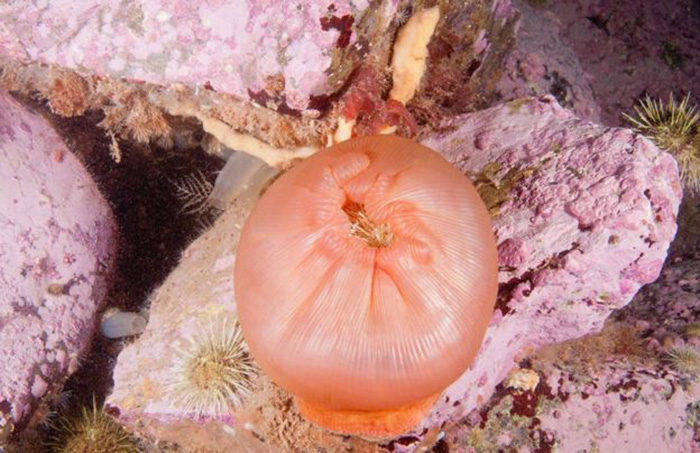The queen is on a trajectory common to most living organisms, apart, that is, from a humble, often overlooked creature of the seashore - the sea anemone.
Once thought to be plants, sea anemones are soft bodied animals that attach themselves to rocks and coral reefs in shallow waters. Their tentacles inject venom into the small fish and shrimp that brush up against them and guide the paralysed prey into the mouth - an opening that also functions as an anus.
There are more than 1,000 species of anemone, varying in size from a few centimetres to more than a metre across. They live in every ocean, from the warmest to the coldest.
The most familiar in the UK is the beadlet anemone. At low tide the tentacles are drawn in and the animals look like blobs of deep red jelly stuck to the rock. But as the water flows, the blobs transform and start to resemble flowers, their tentacles caressing the moving water, searching for food.
The "wondrous elegance of form, the exquisite brilliance of colours, the great variety, the instincts, the powers, the most elaborate apparatus, bestowed on these humble creatures," is described by 19th Century marine biologist Philip Henry Gosse in his book A Year at the Shore. His effusive prose inspired a nation that was just beginning to explore the seaside. His readers used to gather anemones and kept them in aquariums at home.
Usually the anemones didn`t live long but in the right conditions it could have been a very different story.
"As far as we know, these are immortal animals," says Dan Rokhsar, professor of genetics at the University of California, Berkeley. "They live a very long time - one was documented to have lived 100 years. They don`t have old age. They live forever and proliferate, just getting bigger."
If you cut off their tentacles, they grow new ones. Even if you cut off their mouths they grow new "heads." As long as they are not poisoned or eaten, as is often the case, they seem to go on and on.
They appear to avoid ageing and the adverse effects that humans experience over time. "You should see tumours in these animals, but we have very few descriptions of that. They are constantly replenishing themselves without getting cancer," says Rokhsar.
Instead of ageing, anemones seem to stay young and fully functioning. "If I look at a sea anemone today and compare it to a week later the same structure will be there but many of the cells will have been replaced."
How it does this isn`t clear. "We would love to be able to find a gene or pathway that allows it to avoid ageing," says Rokhsar. But he and his team are still searching for that Holy Grail.
Even if they do find what they are looking for, would it shed any light on the human ageing process?
Actually, anemones are more similar to humans than many people realise.
"Sea anemones are the simplest animals we know of that have a nervous system - it`s not organised in the same way as ours, but they do have a network of neurones that allows them to respond to stimuli and be very active predators," says Rokhsar.
Their tentacles can render prey immobile, their mouths can be opened and closed voluntarily, and they have a gut to digest food - all pointing towards a relatively recent common ancestor with humans.
"Sea anemones share a lot with us. We found a lot of similarities we had not seen when comparing humans to fruit flies or nematodes," says Rokhsar. There are parallels in the way the genomes are organised and the way the genes are structured, revealing a link that "goes back at least 700 million years".
But there are philosophical questions too. "To what extent is immortality for a sea anemone and immortality for a human the same kind of thing?" asks Rokhsar.
A sea anemone simply lives in the moment. People, however have thoughts, memories and consciousness that they want to retain. Keeping these bright and present in our regenerating bodies may not be something the anemone can help with. "That," says Rokhsar, "is a much taller order."
More about:
















































